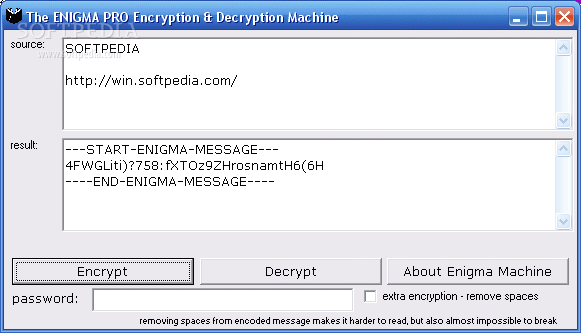
Typex is a British variant of Enigma which was developed in 1934 for the Royal Air Force. Bombe machines were used to discover daily keys, wheel orders, settings, and configurations and while some codes would take several hours to break, not every message could be decrypted. TechRepublic: How tech companies can recruit and retain more womenīetween three and 5,000 Enigma messages were intercepted on a daily basis.

#Decrypting enigma simulator cipher online how to#
How to delete yourself from search results and hide your identity online It has hit 10,000 firms alreadyĪndroid security: How this new malware has become a top smartphone threat This phishing attack can skip your defenses. How to keep your credit card details from being stolen online However, in this case, it is the key, not the cipher, which provides cryptographic strength, and such systems are correctly referred to collectively as one-time pad systems, irrespective of which ciphers are employed.This tiny botnet is launching the most powerful DDoS attacks yet If using a truly random key, which is at least as long as the encrypted message and is used only once, the Vigenère cipher is theoretically unbreakable. The problem with the running key Vigenère cipher is that the cryptanalyst has statistical information about the key elements(assuming that the block of text is in a known language) and that information will be reflected in the ciphertext. This version uses as the key a block of text as long as the plaintext. The running key variant of the Vigenère cipher was also considered unbreakable at one time. If a cryptanalyst correctly guesses the key's length, then the ciphertext can be treated as interwoven Caesar ciphers, which individually are easily broken. The primary weakness of the Vigenère cipher is the repeating nature of its key. However, using the Vigenère cipher, E can be enciphered as different ciphertext letters at different points in the message, thus defeating simple frequency analysis. For instance, if P is the most frequent letter in a ciphertext whose plaintext is in English, one might suspect that P corresponds to E because E is the most frequently used letter in English.

The idea behind the Vigenère cipher, like all polyalphabetic ciphers, is to disguise plaintext letter frequencies, which interferes with a straightforward application of frequency analysis. Phrase LEMON, for example, defines the sequence of ROT11-ROT4-ROT12-ROT14-ROT13, which is repeated until all block of text is encrypted.Īs wikipedia tells us, it is a simple form of polyalphabetic substitution. The sequence is defined by keyword, where each letter defines the needed shift. For example, the first letter of text is transformed using ROT5, second - using ROT17, et cetera. Vigenère cipher is the sequence of Caesar ciphers with different transformations (ROTX, see Caesar cipher). Here is the calculator, which transforms entered text (encrypt or decrypt) using Vigenere cipher. Since we already have Caesar cipher, it seems logical to add the Vigenère cipher as well.


 0 kommentar(er)
0 kommentar(er)
